
views
- Propagate in water by cutting a healthy stem below a node. Place the cutting in water and wait about 2 months for thick, white roots to grow before planting.
- Propagate in soil by placing a cutting in a pot full of moist, well-draining soil. Repot your cutting in a bigger pot when you see new leaves growing.
- Propagate in moss by placing a cutting in a glass of moistened sphagnum moss. Wait about 2 months for thick, white roots to grow before planting in soil.
- Grow roots on an in-tact stem by wrapping moist sphagnum moss and plastic wrap around a node. Cut the stem below the roots once they’ve grown and plant in soil.
Propagating Swiss Cheese Plant in Water
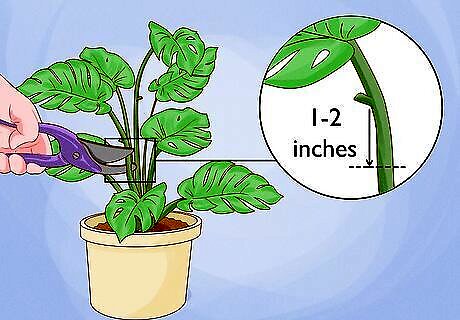
Find a stem with a node and cut 1 to 2 inches (2-5 cm) below it. Look for a healthily growing stem that has other stems, leaves, or a brown aerial root branching off of it. The area where your stem divides and grows is called a node. Simply snip the stem 1 to 2 inches (2-5 cm) below the node with cutting shears or scissors to get your cutting. Choose a stem with at least 1 leaf on it. The more leaves and nodes your stem has, the faster it is likely to grow. Avoid cutting a stem with any damaged, yellow, or wilting leaves.
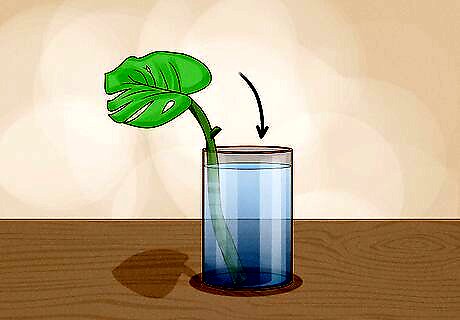
Fill a glass with water and place your stem cutting inside. Find a tall, clear glass or vase that allows your swiss cheese plant cutting to stand upright. Set your cutting inside and pour enough water into the glass so the node and most of the stem are covered. While you don’t necessarily have to use a clear glass, it lets you watch as the roots grow and can help you monitor for any rotting on the stem or roots.

Set your cutting in a location that receives indirect light. Find an area in your home that gets lots of warm light. Just make sure the light isn’t harsh or intense. Swiss cheese plants need lots of light to grow, but direct light can burn their leaves. If you have a window in your bathroom, that can be a great place to set your monstera cuttings. These plants love humidity, so they’ll definitely appreciate the steamy environment. Change the water in the glass every 3 to 5 days, or when the water becomes cloudy. Monsteras are tropical plants and thrive in climates between 60 to 80° F (15-26° C). If you live in a cooler climate, just be sure to keep your plant away from drafty areas.
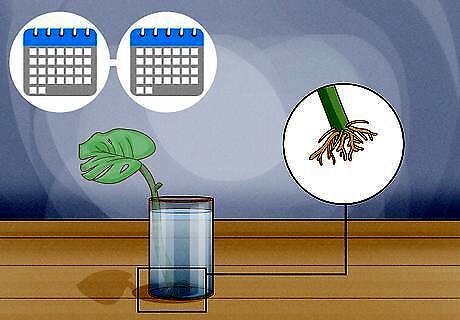
Watch as your cutting grows roots over the next 2 months. Most swiss cheese plants start growing roots after about 1 to 2 weeks. However, their roots need to be nice and long before they’re ready to be potted. Be patient as your plant works its magic and continue to monitor its roots for any rotting. Rotting roots look black and squishy. If you notice any root rot, simply trim off the rotting bit. You’ll know it’s time to pot your cutting when its roots have grown almost as long and thick as the stem.
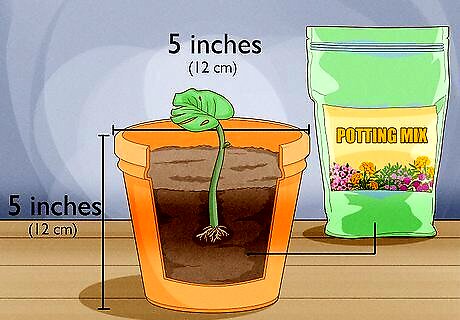
Plant your cutting in soil once it has lots of thick, white roots. Choose a pot with drainage holes that’s at least 5 inches (12 cm) deep and wide. Fill it about half-way full with well-draining soil. Place the cutting inside and fill the rest of the pot with soil. Then, give your new swiss cheese plant a thorough drink of water. Set your new plant in front of a sunny window that doesn’t get harsh, direct light. Let your monstera dry out between waterings. You can tell that it's time to water by sticking your finger about 1 to 2 inches (2-5 cm) deep into the soil. If it's dry, water your plant. It’s totally normal for your monstera to droop a little as it gets used to being in soil. You can also choose to let your plant grow in water! Swiss cheese plants definitely prefer soil, but they can survive for several years in water too. Just make sure to regularly change the water once it's cloudy and transfer it to a bigger vase when its roots start to overtake its current glass.
Propagating in Soil

Make a stem cutting about 1 to 2 inches (2-5 cm) below a node. Find a healthy stem with lots of growing leaves and a branching node. Then, use your cutting shears or sharp scissors to cut the stem 1 to 2 inches (2-5 cm) below the node.
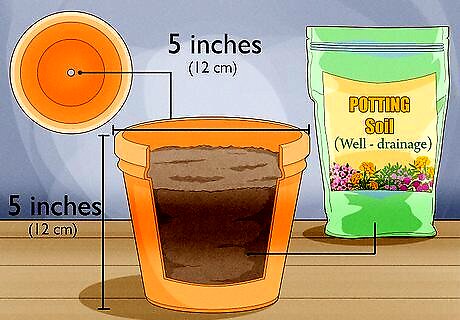
Fill a pot with well-draining soil and water it. Look for a pot that’s about 5 inches (12 cm) deep and wide with drainage holes. Fill the entire pot with well-draining soil. Then, to help prevent your cuttings from drying out, run some water through the soil so that it’s nice and moist.
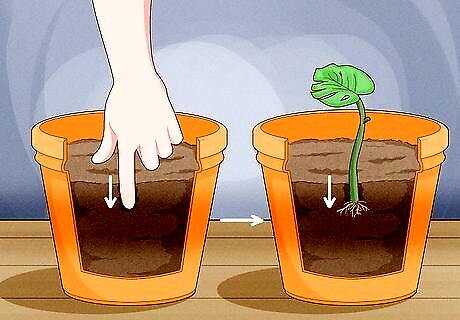
Poke a hole in the soil and place your cutting inside. Use your finger or a pencil to poke a hole into the soil. Add your cutting into the hole so that the node and the bottom of the stem are covered by soil. Then, gently pack the soil around the cutting so that it stands up straight. To help your cutting root and grow faster, dip the bottom of the stem in a rooting hormone before you plant it.
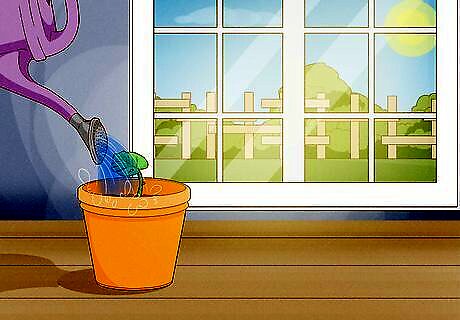
Place the cutting in a sunny location and keep its soil moist. Choose a window where your swiss cheese plant cutting will get lots of warm, indirect light. Every few days, check if the soil is dry by sticking your finger about 1 to 2 inches (2-5 cm) deep into the soil. If it feels dry, water your cutting again to keep the soil moist. It’s completely normal for your cutting to look dry or wilt during the first couple of weeks after being planted. Your cutting currently has no roots to absorb the water, but it’s busy developing them! Because monsteras love humid environments, you can place a plastic bag over your cutting and pot to lock in moisture. This can help its roots grow faster, but it’s not necessary. Just remove the bag when you water.

Watch for new growth forming on your cutting. Because the bottom of your cutting is covered in soil, it can be difficult to know when its roots have fully formed. The best way to tell if your cutting is growing is to look for new, bright green leaves sprouting. This process generally takes longer than water propagation, as it might be 2 months or longer before you see new growth. You can gently tug on your cutting after it's been planted for about a month to see if it’s grown roots. If you feel slight resistance, that likely means it has roots. Be very careful when pulling at your cutting, as its baby roots are very delicate.
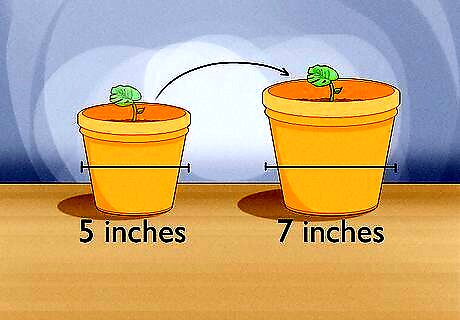
Transplant your new baby plant into a bigger pot. Repot your swiss cheese plant in a pot with drainage holes that’s at least 1 to 2 inches (2-5 cm) taller and wider than the pot it was in. Tilt your current pot and gently twist and pull the plant to get it out. Then, fill the new pot about half-way with well-draining soil. Simply place your plant in the new pot and fill the rest of it with soil. Then give your new plant a good soak! Depending on the size of your cutting and the pot you chose, your new swiss cheese plant might not need to be repotted quite yet. However, these plants typically grow quickly, so if its roots are growing out of the bottom of the container and it looks like it's overgrowing its pot, it's a good idea to transplant.
Propagating in Moss
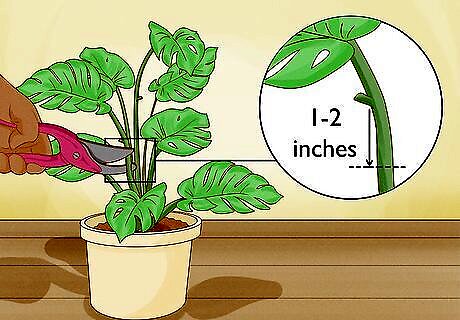
Take a cutting from your plant about 1 to 2 inches (2-5 cm) below a node. Look for a stem that has healthy, green leaves growing and a branching node. With your cutting shears or sharp scissors, simply snip the stem off about 1 to 2 inches (2-5 cm) below the node.

Fill a clear glass with sphagnum moss. Moss is a great potting medium for swiss cheese plants that keeps your cutting moist and encourages root growth. Simply fill a clear glass all the way full with the moss. Propagating with moss is often recommended for more delicate monstera plants like variegated species. You can use perlite or Lightweight Expanded Clay Aggregate (LECA) instead of moss. Propagating with these materials is about the same as with moss, just add about 1 to 2 inches (2-5 cm) of water to your glass.
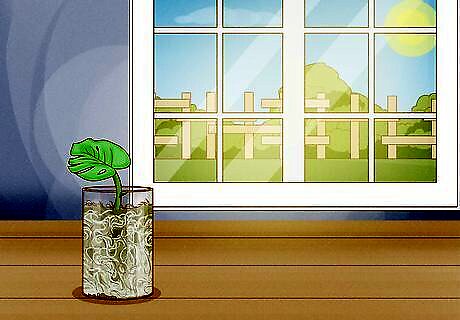
Place your cutting in the moss and set it in indirect light. Gently poke your cutting into the moss. Then, fill your glass with water and carefully drain it so the moss gets moist. Set your cutting in front of a sunny window that receives indirect light so you can watch as it forms roots! Re-moisten your moss when you see that it's dry. Dried out moss will look lighter brown than moist moss. You can also stick your finger about 1 to 2 inches (2-5 cm) deep into the moss to see if it feels dry. To lock in moisture and give your monstera the humid environment it loves, place a plastic bag over your cutting and your glass. This isn’t necessary, but it might help your plant grow roots faster. Dip the bottom of your cutting in a rooting hormone before you plant it to help it grow faster.
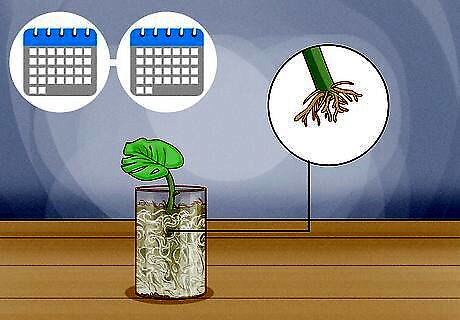
Watch your plant grow roots over the next 1 to 2 months. Your swiss cheese plants will likely start growing little roots after about 1 to 2 weeks. Before you can repot your cutting though, the roots need to be nice and long. During this time, monitor your developing roots for any root rot. If any roots look black and squishy, cut them off.
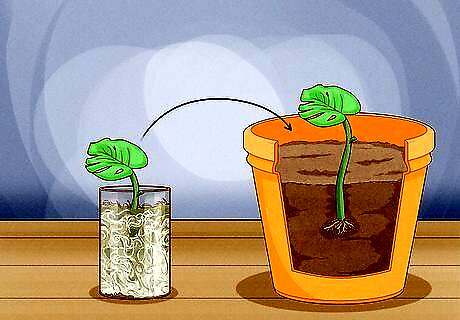
Pot your cutting in soil once it’s grown long, thick roots. Select a pot with drainage holes that’s about 5 inches (12 cm) deep and wide. Then, fill the pot a little less than half-way with well-draining soil. Place the cutting inside the pot with the moss attached. Finish off by filling the rest of the pot with soil and giving your cutting a thorough drink of water. You now have a new swiss cheese plant! You can also remove the moss from your plant–it’s really up to you! Your monstera can grow well with or without the moss attached.
Propagating by Air Layering

Find a healthy stem and node on your plant. With air layering, you encourage your swiss cheese plant to grow roots before you make a cutting! Look for a stem with leaves and a healthy node that you want to cut off once roots have grown.
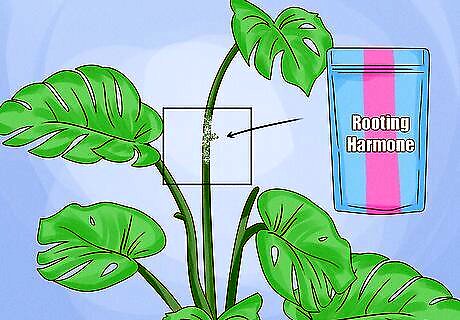
Apply rooting hormone to the node. Adding a rooting hormone to the node helps encourage faster growth and can limit the risk of rotting. Just liberally apply the hormone to the node and a little bit above and below it.

Moisten a ball of sphagnum moss and apply it around the node. Grab a handful of moss and run it under water. Be sure to squeeze out the excess water so the moss is moist but not overly wet. Then, layer the moss over and around the node.
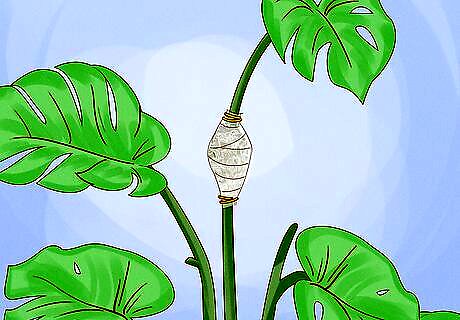
Wrap the moss with plastic wrap and secure it with rubber bands. Cover the underside and sides of the moss with plastic wrap to keep the moss in place. Then, wrap rubber bands or twist ties around the plastic wrap and stem to keep the whole thing in place. You want to keep the top of the moss and stem uncovered so you can moisten the moss when it dries out. When the moss turns a light brown or feels dry, give it a misting of water to moisten it. Alternatively, you can add your moist moss to a plastic bag. Just wrap the bag and moss around the node and secure it with twist ties. Keep the bag open so you can moisten the moss and give the stem and node some air-flow.

Wait for roots to grow over the next several weeks. Your monstera will likely start growing little roots after 2 weeks. However, after about a month, you should see thick, white roots growing through the moss.
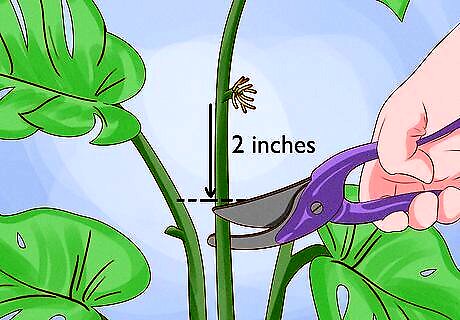
Cut the stem about 2 inches (5 cm) below the roots and pot. Remove the plastic wrap and moss from the stem, node, and roots. Carefully cut the stem with cutting shears or sharp scissors below the roots. Then, fill a pot with drainage holes about half-way full with well-draining soil. Simply place the rooted cutting inside and fill the rest of the pot with soil. Be sure to give your new swiss cheese plant a nice soaking of water!




















Comments
0 comment